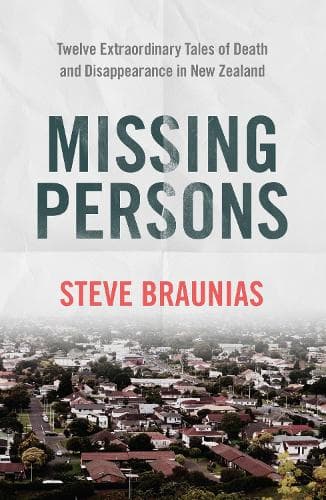Review: Missing Persons
Reviewed by Greg Fleming
In the introduction to his second “true-crime” book Steve Braunias, long one of our finest journalists, strikes a new, confessional tone. He writes of “things narrowing to a point” and of feeling like a “lost soul” while reporting on these 12 cases.
“My personal life was a mess, I had an employment upset, there were health issues...”
If his delightful 2007 ornithology memoir How to Watch a Bird was strung through with intimations of a new love and life, Missing Persons sees Braunias dwelling in the shadows, relationships unravelling, both fascinated and appalled by the men he writes about - and all but two of the chapters here revolve around men.
Men killing women, men who have lost direction, men who are mentally ill; damaged men who damage the ones they love or the stranger they hook up with on Tinder only to dump her body in the Waitakere Ranges: “Self-harm never crossed my mind…” Braunias writes, “but the concept of wandering toward oblivion was very attractive.”
While two stories are new - gripping reports from the trial and then sentencing of Grace Millane’s killer - others have been previously published in the New Zealand Herald but have been revised here and form a powerful whole. Braunias finds particular resonance in the stories of ex-Herald journo Murray Mason and gentle Laotian refugee Socksay Chansy.
Mason was, by all accounts, a friendly chap - well-dressed, liked his beer, followed football - but he was also someone few got close to. When Mason left his bar mates of a night, he didn’t want anyone following him. No-one knew where he lived or if he had a home at all. Then one night in 2018 the 76- year-old walked into Auckland’s Domain where he was found dead the following day. It’s thought he fell down the bank.
It’s a superb piece. The reader starts out with a degree of sympathy for Mason. We meet ex-drinking buddies who all have good things to say. “He was a fantastic joker,” remembers one. Then Braunias meets his daughter, ex-wife and others who knew him as a younger man and a darker, troubled and abusive side of Mason is revealed.
Bad luck, bad inside? Braunias doesn’t judge but gives Mason the benefit of the doubt: “He’d come to peace in his final years. He had friends who loved him. He had his itinerary, his routines.” Mason’s mysterious later life seen as part of a quiet redemption.
Socksay’s story starts out as one of promise - a film job in Berlin, parties, his life the envy of his friends - then his mental health unravels, he cuts ties and (like Mason as well as the unsolved disappearance of autistic man Nigel Peterson from Rotorua in 2017 that Braunias writes about) becomes fatally adrift.
Socksay returns to New Zealand and wanders Auckland homeless, haunted by the voices in his head. He is found dead, at 36, a few months later. When local friends gather to mourn him, Braunias fashions one of his perfect, hits-you-where-it-hurts sentences: “It was a very New Zealand send-off - beers, low voices.”
Not every story here involves a death or literal disappearance or deserves mourning. Two cases midway through provide a little relief after the disturbing trials of Grace Millane’s killer, the odious Jesse Kempson, Susan Burdett’s belatedly convicted killer Malcolm Rewa and a surreal interview with Simonne Butler whose hand was severed by her meth-addict boyfriend Tony Dixon in 2003.
Kim Dotcom and one-time Conservative party leader Colin Craig are still very much with us. Their “disappearances” are political; the spotlight shifted.
Braunias sees a deranged love story in the cruel and endless litigation Craig takes over his ex-press secretary’s sexual harassment claim. “He wanted to possess her and be the man in her life, and in a terrible sense he achieved exactly that: she couldn’t get rid of him, because he hounded her for years in the court.”
Kim DotCom, exiled to Queenstown and still fighting US extradition on copyright charges, burbles on about the inevitability of World War Three: “They will not be knocking on the door and asking politely for food, they will shoot you in the head and take it.”
Both men seem unhinged, pathetic; Braunias’s deft, hands-off portraits reminding one what a toxic mixture megalomania and great wealth can be.
Each of the 12 stories combine a journalist’s rigorous research with a novelist’s eye for story and structure. Crime can be a near neighbour, too, and Braunias also follows two stories which take place near his Te Atatu home.
“The murder capital of New Zealand is the suburbs,” he writes. “Most violent crime takes place in a house on a quiet street, with junk mail in the letterbox and a tricycle left out in the driveway.”
It’s a riveting, one-sitting read; sometimes wandering, unmoored, among the damned and dispossessed pays dividends.
Reviewed by Greg Fleming
